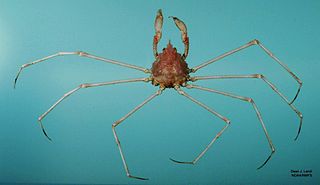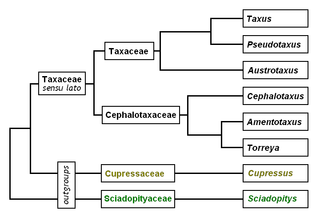
Taxus is a genus of coniferous trees or shrubs known as yews in the family Taxaceae. They are relatively slow-growing and can be very long-lived, and reach heights of 2.5–20 m (8.2–65.6 ft), with trunk girth averaging 5 m (16 ft). They have reddish bark, lanceolate, flat, dark-green leaves 10–40 mm long and 2–3 mm broad, arranged spirally on the stem, but with the leaf bases twisted to align the leaves in two flat rows either side of the stem. The oldest known fossil species are from the Early Cretaceous.

Castanopsis, commonly called chinquapin or chinkapin, is a genus of evergreen trees belonging to the beech family, Fagaceae. The genus contains about 140 species, which are today restricted to tropical and subtropical eastern Asia. A total of 58 species are native to China, with 30 endemic; the other species occur further south, through Indochina to Indonesia and the Philippines, mountainous areas of Taiwan, and also in Japan. The English name chinkapin is shared with other related plants, including the golden chinkapins of the Pacific United States, which are sometimes included within Castanopsis but are more often considered a separate but very closely related genus, Chrysolepis.

Eriocoma hymenoides is a cool-season, perennial bunchgrass with narrow, rolled leaf blades. It is native to western North America east of the Cascades from British Columbia and Alberta south to southern California, northeastern Mexico, and Texas.

Castanopsis cuspidata is a species of Castanopsis native to southern Japan and southern Korea.
The narrow sawfish, also known as the pointed sawfish or knifetooth sawfish, is a species of sawfish in the family Pristidae, part of the Batoidea, a superorder of cartilaginous fish that include the rays and skates. Sawfish display a circumglobal distribution in warm marine and freshwater habitats. Their extant biodiversity is limited to five species belonging to two genera. The sawfishes are characterised by the long, narrow, flattened rostrum or extension on their snout. This is lined with sharp transverse teeth, arranged in a way that resemble the teeth of a saw and are used for killing prey. It is found in the shallow coastal waters and estuaries of the Indo-West Pacific, ranging from the Persian Gulf to southern Japan, Papua New Guinea and northern Australia. It is the only living member of the genus Anoxypristis, but was previously included in the genus Pristis. Compared to Pristis, Anoxypristis has a narrower rostral saw with numerous teeth on the distal part and no teeth on the basal one-quarter. It reaches a length of up to 3.5 m (11 ft).

Olea europaea subsp. cuspidata is a subspecies of the well-known olive tree, which until recently was considered a separate species and is still mentioned as such in many sources. Native to northeast of Africa and the drier parts of subtropical Asia, it has various common names, including wild olive, African olive, brown olive and Indian olive.

Carcharias is a genus of sand tiger sharks belonging to the family Odontaspididae. Once bearing many prehistoric species, all have gone extinct with the exception of the critically endangered sand tiger shark.
Gulella cuspidata is a species of very small air-breathing land snails, terrestrial pulmonate gastropod mollusks in the family Streptaxidae.
Myrciaria cuspidata, commonly known as camboim, or cambuím is a species of plant in the family Myrtaceae. It is found in coastal forests and semideciduous forests in Brazil, Paraguay and Argentina. It grows slowly to a semideciduous shrub or small tree, between 3 and 6 metres tall, with orange or black berries around 10mm in diameter.
Shorea cuspidata is a species of plant in the family Dipterocarpaceae. It is endemic to Borneo. It is listed on the IUCN Red List as Vulnerable, and populations are known to occur in the Bako and Lambir Hills.

Chorizanthe cuspidata is a species of flowering plant in the buckwheat family known by the common name San Francisco spineflower. It is endemic to California, where it is known only from the San Francisco Bay Area and to the immediate north and south. It grows in sandy coastal habitat.
T. cuspidata may refer to:

Muhlenbergia cuspidata is a species of grass known by the common name plains muhly. It is native to North America where it is distributed across central Canada and the central United States.

Pyromaia cuspidata, also known as the dartnose pear crab, is a species of crab in the family Inachoididae. This crab appears similar to Anasimus latus. It is a long-legged crab with a trident-shaped rostrum, and occurs in Atlantic waters from North Carolina to west Florida, and in the Gulf of Mexico through the Yucatán Peninsula down to Nicaragua. It is also found in Cuban waters. This species lives in depths of 27–549 metres (89–1,801 ft) on bottoms of mud, sand, or pebbles.

Yew is a common name given to various species of trees.
The genus Clio is a taxonomic group of small floating sea snails, pelagic marine opisthobranch gastropod mollusks, the sole genus belonging to the family Cliidae

Doto cuspidata is a species of sea slug, a nudibranch, a marine gastropod mollusc in the family Dotidae.
Thryptomene cuspidata is a species of flowering plant in the family Myrtaceae and is endemic to Western Australia. It is a dense erect shrub that typically grows to a height of 0.6–2.2 m and blooms between July and November producing white or pink flowers.

Poa cuspidata, commonly called early bluegrass, is a species of flowering plant in the grass family (Poaceae). It is native to the eastern United States, where its range extends from Appalachian regions into the Coastal Plain, where it is less common. In the Appalachian mountains, it is a common species found in forest openings.












